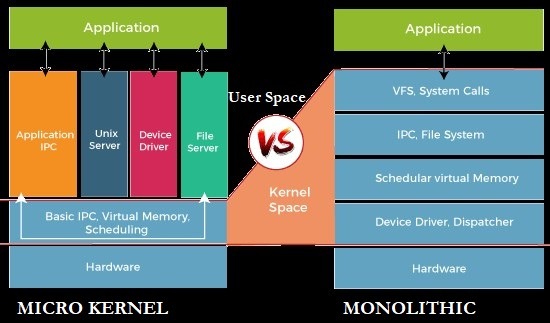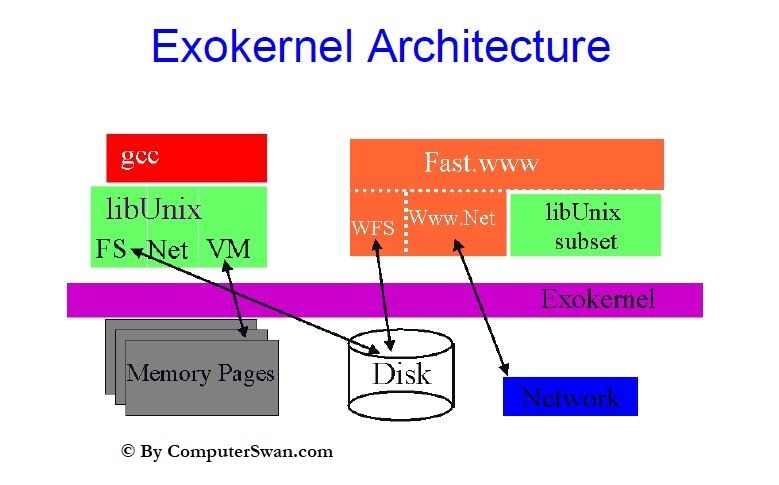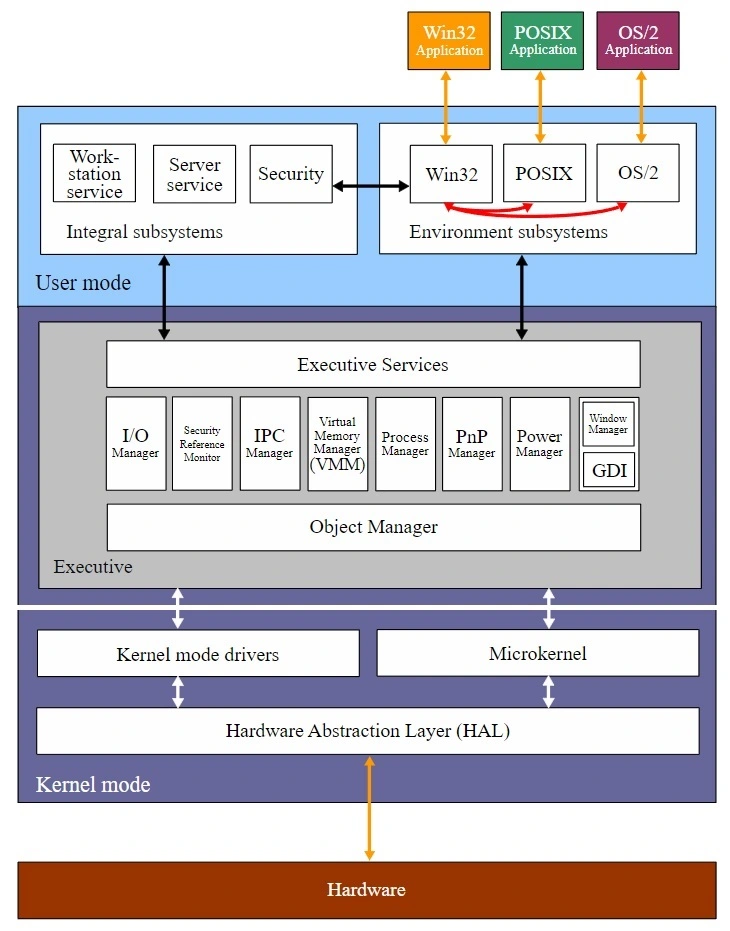Table of Contents
ToggleExploring the Kernel: The Heart of Your Operating System
A kernel is the most important program of the operating system package. It can be said that it is the boss of the entire operating system. It has control over the entire operating system, everything in it, every functioning system.
The kernel does not directly interact with the user. Establishes coordination and communication with other programs, hardware, devices, processors, memory, disk drives, shells, etc. of the operating system. The kernel monitors and controls every event and functioning of the operating system, this can be understood through this diagram.

The kernel itself is a program of the operating system that is first loaded into the memory of the computer at the time of booting and as long as the computer is running, this program remains there and from there, monitoring, controlling, management all the tasks are done by the kernel. It sits well and performs well.
kernel is an old operating system development architecture. It is in a single layer in which all the major components and functions reside. There is little information hiding in it, due to which different computer users can call procedures with each other.
In the kernel architecture, the kernel directly interacts with the hardware and friends, monolithic kernel is easily loaded into the main memory at the time of booting while starting the computer. MS-DOS operating system is an example of a monolithic kernel.
Friends, you will find monolithic kernels in the Linux operating system, Android operating system, Firefox operating system, Google operating system, and Google Chrome operating system.
You can also say that it is the central core of the operating system. Along with running the computer, the kernel performs some important functions like memory management, process management, file management, input/output management, communication management (IPC), etc. In this post, we got to read a new word which we called “shell“. Let us see what is shell.
What is Shell in operating system (OS) :
Just as the kernel is a program in the operating system, similarly there is another program in the operating system named Shell. Shell provides an interface to the user, its main function is to read the commands and take them to the kernel to make them understand that the user has given this command and wants to get this work done, then the kernel takes that command from that shell and executes it through other hardware and programs. Gets that command completed by executing it. We give instructions or commands to the computer in two ways.
Graphical User Interface (GUI) -
GUI – Through graphical user interface – where the user does not give instructions by writing commands but gives commands through a graphical interface environment by pressing buttons through window menus, using the mouse.
In another words we can say that A graphical user interface (GUI) is a digital interface where a user engages with graphical elements like icons, buttons, and menus. Within a GUI, the visuals showcased in the user interface not only provide pertinent information to the user but also offer them a platform to initiate various actions.

Command-Line Interface (CLI) -
A shell, commonly referred to as a command-line interface (CLI) in Linux, serves as a user interface through which users can tap into an operating system’s array of services. Basically, a CLI functions as a computer program capable of interpreting and executing commands provided in the form of text lines. The user’s interaction with the shell predominantly occurs through this command-line interface. In Windows based operating systems CLI is known as CMD (Command Prompt).
Types of Kernel in Operating System (OS) :
1. Monolithic Kernel In OS -
Monolithic kernels are larger in size because in monolithic kernels, all the components (major functionality) reside in the ‘Address Space’ present inside the kernel. Component or functionality means network statistics, memory management, input-output management, process management, device drivers, Interprocess communication, CPU scheduling, and other major and critical tasks.
Due to the presence of so many major functions in the address space inside the kernel, the size of the monolithic kernel is large. Monolithic kernels are very fast. In the monolithic kernel, all the major components and functionalities are present in the address space of the kernel itself, from where the kernel can easily interact with them. In a monolithic kernel, the kernel works by easily calling these major component functions through procedure/procedure calls, just like we call functions in a C program.
In a monolithic kernel, there are numerous lines of code. because there are many major components and functionalities in the address space of the kernel, due to which their size is large, Due to this it is very difficult to ‘Debug‘ because all the major components and functionalities are in the address space of the kernel.
It is very difficult to make any new update or add new functionality in the monolithic kernel because as you know by now, the size of the monolithic kernel is large due to the excessive number of code lines where the new function Or updating or adding functionality is quite difficult and risky and takes a lot of time.
In a monolithic kernel, if any component crashes, then all the components of the system crash. This happens in a monolithic kernel because all the major components and functions are in the address space of the kernel itself, as we see in any program of C programming language.
Suppose people write five different functions which are components of the main function. If any one function stops working or does not work then our program gives compilation or segmentation error during compilation. If all the functions are in different programs. When a program is written, if one function does not work, then the other functions of the different programs will continue to work, which happens in the ‘Micro Kernel‘.

Examples of Monolithic Kernel Architecture -
Unix kernels, BSD, FreeBSD, NetBSD, OpenBSD, MirOS BSD, SunOS, UNIX System V, AIX, HP-UX, Solaris, OpenSolaris / illumos, Unix-like kernels, Linux, DOS, DR-DOS, MS-DOS, Microsoft Windows 9x series (95, 98, 98 SE, ME), FreeDOS, OpenVMS, TempleOS, XTS-400, z/TPF
2. Micro Kernel In Operating System (OS) -
In a microkernel, the address space contains only the most important components such as interprocess communication and scheduling, which makes it smaller in size, and other important component functionalities are present in the ‘user-space’ rather than in the kernel space, which helps in tracking the network state, memory management, input-output management, device driver management, etc. exist in the userspace and work.
In a microkernel, other major components are in the ‘user-space’, for which the kernel has to go out of its own address space and go into the userspace for integration, which takes time, due to which the kernel becomes slow.
In microkernel, the kernel has to access major components present in the userspace through message passing, due to which these kernels are slow. There are very few code lines in a microkernel because most of the important components are present in the user space rather than in the kernel space, due to which the size of the kernel is small.

In microkernel, the size of the kernel is small because most of the major components and functionality are not present in the address space of the kernel but in the address space of the user, hence there are very few code lines in the address space of the kernel which makes it easier to run the program. Can debug the code.
It is very easy to add any new function or functionality in a microkernel because as you have come to know, the size of the microkernel is small and the code lines are very small, due to which any new function or functionality can be easily updated by writing it in code lines.
If any one component in the microkernel fails or crashes, the other components continue to work continuously. In microkernel, as I said, most of the components or functions are programmed in a parallel manner in different user-space outside the kernel address space, so that if one function crashes, the others keep doing their work.
Examples of Microkernels -
Examples of microkernels include the QNX Neutrino microkernel, known for its real-time capabilities and stability, making it a popular choice in embedded systems, especially in the automotive and medical industries. Another prominent example is MINIX, which played a pivotal role in teaching operating system principles. Apple’s XNU kernel, utilized in macOS and iOS, employs a hybrid structure with microkernel elements, contributing to the stability and security of Apple’s devices.
3. Exo Kernel In Operating System (OS) -
Exo kernel is a kernel of old technology, usually, its size is very small because it has limited functionality. This kernel was invented by the MIT Parallel and Distributed Operating Systems group. Exo Kernel is based on the architecture of a virtual machine in which duplicate offices of the operating system can be created.
The kernel contains a program called ‘exokernel‘ which is located in the bottom layer of the operating system. The exo kernel easily performs functions like resource allocation for virtual memory. The biggest advantage of this type of kernel is that it monitors the resources allocated to the virtual machine.

Examples of Exo Kernel -
There are a few notable examples in the world of exo kernels. “Nemesis,” a project from the University of Cambridge, is a standout, enabling applications to manage hardware resources with precision, often leveraged in research and specialized systems.
“ExOS,” short for Exokernel Operating System, explores the potential of exokernels by providing direct access to hardware resources for applications, prioritizing performance optimization.
Additionally, “Fluke,” developed at the University of Washington, delves into exokernel concepts by emphasizing control over hardware resources while maintaining robust security and isolation.
These examples showcase the research and experimentation involved in exokernel development, and while not widely adopted, they offer insights into the possibilities of extreme resource management in operating systems.world
4. Hybrid Kernel In Operating System (OS) -
Hybrid kernels are an interesting concept in the world of operating systems that match the best of two worlds, combining elements of both monolithic and microkernel designs. This unique approach results in a versatile and efficient OS architecture that brings remarkable benefits to a variety of devices and applications.
The key benefit of hybrid kernels is the ability to strike a balance between performance and flexibility. This preserves the efficiency of a monolithic kernel by keeping essential system functions within kernel space, which translates into faster communication and resource sharing.
Additionally, it provides the modularity of a microkernel by allowing some drivers and non-essential components to operate in user space. This flexibility not only increases stability but also simplifies maintenance and system updates.
Examples of Hybrid Kernel Architecture -
A prime example of a hybrid kernel is the Microsoft Windows NT family series of operating systems, which includes Windows 2000, XP, and newer versions like Windows 10 and 11. Windows NT’s hybrid design enables it to run on a wide range of hardware configurations while maintaining a strong and stable core. Its adaptability has made it a preferred choice for both personal computers and enterprise environments.
Another notable example of a hybrid kernel is macOS, developed by Apple. MacOS This design has driven the Mac ecosystem for years, making it an attractive option for creative professionals and everyday users.
Finally, the hybrid kernel is a notable innovation in the field of operating systems, combining the strengths of monolithic and microkernel designs. Its flexibility, performance, and adaptability have made it a key player in modern computing, exemplified by operating systems such as Windows NT, macOS, and even some aspects of the Linux ecosystem.

FAQ'S Related To Kernel in OS.
Q: What is the kernel in an operating system (OS), and why is it important?
A: The kernel in an OS is its core component, responsible for managing hardware resources, scheduling tasks, and acting as an interface between software and hardware. It’s crucial for the OS’s functioning.
Q: Can you explain the concept of the kernel in simple terms?
A: At its core, the kernel is like the conductor of an OS orchestra, ensuring all software and hardware components work together harmoniously.
Q: What are the functions of the kernel in an operating system?
A: The kernel performs essential tasks like process management, memory management, device control, and system calls.
Q: How does the kernel in an OS relate to the rest of the system?
A: The kernel interacts with the system’s hardware, facilitating communication and resource management for software applications.
Q: What is the difference between user space and kernel space in the operating system?
A: User space is where applications run, while kernel space is reserved for the OS and trusted system processes, ensuring security and stability.
Q: What are the types of kernels in OS design?
A: Kernels can be categorized as monolithic, microkernel, hybrid, and more, each with distinct design principles and trade-offs.
Q: Can you provide an example of a kernel in an operating system?
A: The Linux kernel is a widely recognized example, serving as the foundation of the open-source Linux operating system.
Q: What is the role of the kernel in computer systems?
A: The kernel acts as the bridge between hardware and software, managing hardware resources and enabling software to function.
Q: How does the kernel interact with hardware in an OS?
A: The kernel communicates with hardware devices through device drivers, enabling software applications to access and utilize hardware resources.
Q: What is the difference between the kernel and shell in an operating system?
A: The kernel is the core of the OS, managing system resources, while the shell is a command-line interface that allows users to interact with the OS.
Q: Why is the kernel an essential component of any operating system?
A: The kernel provides crucial functionalities like process management and hardware resource allocation, making it indispensable for OS operation.
Q: What is a kernel thread in the context of an OS?
A: Kernel threads are lightweight processes managed by the kernel, performing tasks that require kernel-level access.
Q: What is a microkernel in an operating system, and how does it differ from other types of kernels?
A: A microkernel is a minimalist design that moves many traditional kernel functions to user space, emphasizing modularity and security.
Q: What is a monolithic kernel, and when is it used in OS design?
A: A monolithic kernel contains most operating system functions within a single, tightly integrated unit. It’s commonly used in traditional OSs like Linux.
Q: How does the Linux kernel fit into the broader operating system?
A: The Linux kernel serves as the core of the Linux operating system, managing hardware resources and facilitating communication between software and hardware.
Q: Can you explain the role of the kernel mode in an operating system?
A: Kernel mode is a privileged state where the kernel has unrestricted access to system resources, while user mode provides a restricted environment for applications.
Q: What are the primary responsibilities of the kernel in an OS?
A: The kernel’s main responsibilities include process management, memory allocation, file system handling, and device management.
Q: What is the kernel’s significance in managing hardware resources?
A: The kernel plays a pivotal role in allocating and managing CPU, memory, and other hardware resources, ensuring efficient and secure resource utilization.
Q: How is the kernel loaded and initialized during the boot process?
A: During the boot process, the kernel is loaded into memory, initialized, and begins executing its functions, setting up the operating system.
Q: What is the history of kernel development in operating systems?
A: Kernel development has a rich history, evolving from monolithic designs to microkernels and hybrids, reflecting advancements in computer science.
Q: What is the relationship between the kernel and device drivers?
A: Device drivers act as intermediaries between the kernel and hardware devices, enabling the kernel to communicate with and manage hardware resources.
Q: How can I switch from user mode to kernel mode in an OS?
A: The transition to kernel mode typically occurs through system calls, which allow user programs to request kernel services while maintaining security and stability.
Q: What are the advantages of using a microkernel in operating systems?
A: Microkernels offer modularity, improved security, and flexibility by moving many OS functions to user space, simplifying maintenance and development.
Q: What are the potential drawbacks of a monolithic kernel design?
A: Monolithic kernels can become large and complex, making them less modular and potentially less secure compared to microkernels.
Q: How is the kernel structured in a Linux operating system?
A: The Linux kernel has a modular structure, with loadable kernel modules that provide additional functionality when needed. This enhances flexibility and reduces the kernel’s size.
Q: Are there any real-world examples that illustrate the importance of the kernel in OS operation?
A: Yes, for instance, the kernel ensures your computer can run various software, like web browsers, and controls hardware access, enabling tasks such as printing and network communication.
Q: What are the key components of the kernel in an OS, and how do they work together?
A: The kernel comprises several key components like the process scheduler, memory manager, file system, and device drivers, working together to manage the system’s resources.
Q: How does the concept of the kernel vary in different operating systems like Linux and Windows?
A: While the core functions are similar, differences exist in terms of architecture, design philosophy, and how specific tasks are handled.
Q: Is there a difference between the kernel in operating systems and the kernel in mathematics or other fields?
A: Yes, the term “kernel” can have different meanings in various contexts, but in the context of operating systems, it refers to the core component managing system resources.

